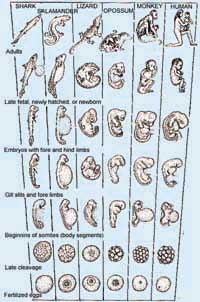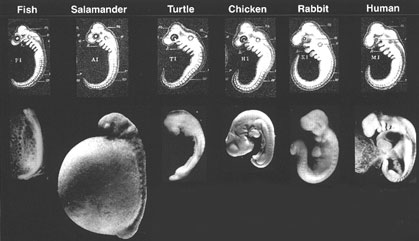“Truth in science can be defined as the working hypothesis best suited to open the way to the next better one.”
– Konrad (Zacharias) Lorenz (1903-89) Austrian ethologist. [Nobel prize for medicine, 1973]
 I’ve caught some criticisms over the past year and a half since I posted this image in my article summarizing evolution, where I erroneously accepted Ernst Haeckel’s theory of “Embryonic Recapitulation,” or that an organism’s embryonic development mimics the evolutionary development of those organisms leading up to it. Stephen J. Gould, in his book Ontogeny and Phylogeny, tackles the very complex reasons for why this theory fails. Haeckel’s drawings, shown here, were not faithful to their subjects, and exaggerated the similarities between the different embryos while minimizing their differences. As we can see with the following comparison between Haeckel’s drawings and actual images:
I’ve caught some criticisms over the past year and a half since I posted this image in my article summarizing evolution, where I erroneously accepted Ernst Haeckel’s theory of “Embryonic Recapitulation,” or that an organism’s embryonic development mimics the evolutionary development of those organisms leading up to it. Stephen J. Gould, in his book Ontogeny and Phylogeny, tackles the very complex reasons for why this theory fails. Haeckel’s drawings, shown here, were not faithful to their subjects, and exaggerated the similarities between the different embryos while minimizing their differences. As we can see with the following comparison between Haeckel’s drawings and actual images:

Lacking a scientific background, it’s important for me to revisit and correct inaccuracies I post on this site, especially as this site was intended as a place for me to flesh out my understanding of science and my worldviews. When I found out Embryonic Recapitulation theory was wrong, I was stunned; after all, it makes perfect sense. Haeckel’s deception aside, human embryos really do go through stages where they resemble segmented worms, fish, amphibians, and reptiles. Consider this quote from Carl Sagan, which primed me to believe in the ER theory:
“By the third week . . . it looks a little like a segmented worm. By the end of the fourth week . . . it’s recognizable as a vertebrate, its tube-shaped heart is beginning to beat, something like the gill arches of a fish or an amphibian have become conspicuous, and there is a pronounced tail. It looks something like a newt or a tadpole…. By the sixth week . . . the eyes are still on the side of the head, as in most animals, and the reptilian face has connected slits where the mouth and nose eventually will be….
By the end of the eighth week the face resembles a primate’s but is still not quite human.”
– Carl Sagan
“Is It Possible To Be Pro-Life and Pro-Choice“. Parade Magazine, 22 April 1990
It can’t simply be coincidence that embryos go through these stages of resembling their more primitive ancestors. It cannot be unreasonable to look at these stages in embryonic development and see increasing layers of complexity. What’s wrong with drawing such conclusions from these observations? As Encarta notes:
Such similarities formed the basis for German biologist Ernst Haeckel’s biogenetic law, which states that an animal’s embryonic development recapitulates its evolution. Although scientists now know that this law does not hold absolutely, Haeckel’s idea has remained influential.
– “Vertebrate Embryos” from Encarta
So I hit the books– Ummm… Okay, so I hit the Internet, and tried to understand how I was taken in by this seemingly plausible, however incorrect, theory. This was very difficult, I quickly found, because Creationist disinformation has so overwhelmed the Internet for this topic.
Haeckel has become a sort of rhetorical Holy Grail of Intelligent Design advocates, keeping with their misguided reliance on disproving evolution as a means of “proving” intelligent design. They revel in his “hoax” drawings, and delight in using words like “totally discredited” to describe his theory, but these are unfair characterizations.
The major problem with Haeckel’s theory is that embryonic development does not trace a clear-cut path through our genetic lineage. For instance, were Recapitulation Theory absolutely true, then we would see the human embryo go through a distinctly chimpanzee-like stage as it developed through our two species’ common ancestor, but this does not happen. Instead, despite our genes being 95-98.5% identical, our embryonic developments take distinctly different paths between week seven and 19, when the genes believed responsible for development of the cerebral cortex kick into action in humans.
Another problem with Haeckel’s theory is that it fails to account for Analogous structures, similar traits in different species that evolved independently. The eye is a trait that (sort of) evolved in more than one species separately. Wings evolved separately in birds, insects, bats, and dinosaurs.
Despite Creationist oversimplifying his theories and unfairly characterizing their validity to discredit Haeckel’s legacy and evolution in general, the fact remains that the scientist contributed greatly to the lexicon of Evolutionary Theory and provided the framework for our current understanding of the Evolutionary Process. We continue to employ this understanding of evolution to our modern research. Consider this observation on a whale missing-link recently found by archeologists:
Janjucetus throws new light on the evolution of baleen whales. Such whales were already known to have originated from toothed whales; modern baleen whales go through a stage as embryos in which they have teeth. (Emphasis mine)
– “Ancient whale ‘truly weird’” nature.com
Haeckel’s theory is wrong not because the evidence available to him did not support his theory, there are inarguable similarities in embryonic development across species that are evidence of evolution, but because later facts contradicted his theory. “ontogeny recapitulates phylogeny” was simply the first draft of a theory based on Comparative Anatomy. The fact remains that embryos of different species do resemble one another, just as mature representatives of species may share traits. Haeckel’s specific theory fails because the reality is much more complex. Evolution is a series of increasing layers of complexity in a very broad and oversimplified sense, but the details of evolutions’ means are a myriad of mechanisms and strategies. Evolution is not a tree growing ever upward, but a complex web of interconnections.
Homologous structures, Vestigial Organs, and similarities in embryonic development are all part of the overwhelming evidence supporting Evolutionary Theory. It doesn’t matter that Haekel’s specific theory was wrong, because he was on the right track. Just homo sapiens are the latest and greatest version of the primates, our modern understanding of Evolutionary Theory is the latest and greatest over Ernst Haekel’s. Humans will continue to evolve and our understanding of reality will continue to evolve with us.
Further Reading:
Wikipedia article on “Recapitulation theory”